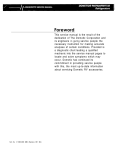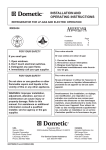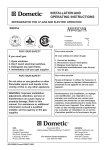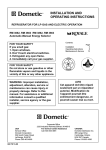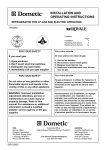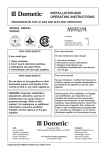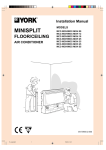Download Dometic RM7732 Operating instructions
Transcript
RECORD THIS INFORMATION FOR FUTURE REFERENCE BEFORE INSTALLING THE UNIT: Model No. _______________ Serial No. ______________________ Date Purchased ___________ Place of Purchase _______________ MODEL RM7732 Automatic Ener gy Selector Energy USA SERVICE OFFICE The Dometic Corp. 509 So. Poplar St. LaGrange, IN 46761 219-463-4858 CANADA Dometic Dist. 866 Langs Dr. Cambridge, Ontario CANADA N3H 2N7 519-653-4390 For Service Center Assistance Call: 800-544-4881 REFRIGERA TOR FOR LP/GAS REFRIGERAT AND ELECTRIC OPERA TION OPERATION FOR YOUR SAFETY If you smell gas: 1. Shut off gas supply at main valve. 2. Open windows. 3. Don't touch electrical switches. 4. Extinguish any open flame. 5. Immediately call your gas supplier. FOR YOUR SAFETY Do not store or use gasoline or other flammable vapors and liquids in the vicinity of this or any other appliance. INST ALLA TION & INSTALLA ALLATION OPERA TING INSTR UCTIONS OPERATING INSTRUCTIONS Form No. 3106864.006 12/95 The Dometic Corp. LaGrange, IN 46761 Copyright 1995 The Dometic Corporation INDEX Page Installation .............................. 2 Operating Instructions ............ 8 Maint. & Service ..................... 112 This Manual should be read and understood before installation, adjustment, service or maintenance is performed. This unit must be installed and serviced by a qualified serviceman. Modification of this appliance can be extremely hazardous and could result in personal injury or property damage. Lire et comprendre ce manuel avant de procéder à l'installation, à des réglages, de l'entretien ou des réparations. L'installation et l'entretien de cet appareil doivent être effectués par un réparateur qualifié. Toute modification de cet appareil peut être extrêmement dangereuse et entraîner des blessures ou dommages matériels. REFRIGERA TOR REFRIGERAT MODEL RM7732 Product No. 921148003 IMPORTANT INSTRUCTIONS READ CAREFULLY SECTION A. INST ALLA TION INSTALLA ALLATION The lower side vent is fitted with a panel which provides an adequate access opening for ready serviceability of the burner and control manifold of the refrigerator. This should be centered on the back of the refrigerator. 1. GENERAL INSTRUCTIONS This appliance is designed for storage of foods and storage of frozen foods and making ice. The refrigerators outlined herein have been design certified by A.G.A. under ANSI Z21.19 Refrigerator Standard for installation in a mobile home or recreational vehicle and are approved by the Canadian Gas Association. The certifications are, however, contingent on the installation being made in accordance with the following instructions as applicable. 3. CERTIFIED INSTALLATION Certified installations require one roof vent and one lower side vent. For certified vent system kits, see Section B. For further information, contact your dealer or distributor. In the U.S.A., the installation must conform with: 1. National Fuel Gas Code ANSI Z223.1-(latest edition) 2. Manufactured Home Construction and Safety Standard, Title 24 CFR, Part 3280 3. Recreational Vehicles ANSI A119.2-(latest edition). 4. METHOD OF INSTALLATION The method of installation is shown in FIG. 1. It is essential that all maximum or minimum dimensions are strictly maintained as the performance of the refrigerator is dependent on adequate flow of air over the rear of the refrigerator. The unit must be electrically grounded in accordance with the National Electric Code ANSI/NFPA 70-(latest edition) when installed if an external alternating current electrical source is utilized. NOTE NOTE: The upper vent should be centered over the condenser coil at the back of the refrigerator. 4. Any applicable local code. In Canada, the installation must conform with: 1. Current CGA B 149 Gas Installation Codes 2. Current CSA Standard Z 240.4 GAS-EQUIPPED RECREATIONAL VEHICLES AND MOBILE HOUSING 3. Any applicable local code The unit must be electrically grounded in accordance with the CANADIAN ELECTRICAL CODE C 22 Parts 1 and 2. FIG. 1 MINIMUM VENTILATION HEIGHT 2. VENTILATION The installation shall be made in such a manner as to separate the combustion system from the living space of the mobile home or recreational vehicle. Louvers for air supply or for venting of combustion products shall have a minimum dimension of not less than 1/4 inch. See Sec. B for approved vents. Proper installation requires one fresh air intake and one upper exhaust vent. The ventilation kits shown in this instruction manual have been certified for use with the refrigerator model listed in the Table. For "Certified Vent System Kits" see Section B. The ventilation kits must be installed and used without modification. An opening toward the outside at floor level in the refrigerator compartment must be provided for ventilation of heavier-than-air fuel gases. The lower vent of the recommended kits is provided with proper size openings. The flow of combustion and ventilation air must not be obstructed. 2 6. CLEARANCES 5. VENTILATION HEIGHTS Minimum clearances in inches are: G : Top K: Side L: Bottom M : Rear N: Refer to FIG 1., Page 2 Installation with roof vent and lower side vent Minimum Ventilation heights in: REFRIGERATOR INCHES MM 65 1651 RM7732 NOTE: Clearance "N N" is the distance between the bottom of the lower vent to the roof material. For ventilation height, refer to Section A. Installation, Item 5. Ventilation Heights. See FIG. 2. 3-1/2" 3-1/2" NOTE: Wood strip MUST be in place. See Page 4, Item 7 FIG. 2 28-7/8" NOTE: RADIUS CAN BE +1/4"–0" HEIGHT AND WIDTH ± 1/8" FIG. 3 Refrigerator Model RM7732 Overall Dimensions Recess Dimensions Height A Width B Depth C Height H Width W Depth D (Inches) 59-5/8 33-9/16 25-15/16 59-1/16 32-11/16 24 852 659 1498 830 610 (mm) 1523 0" 0" 0" 0" 65" M" is between the rearmost part of NOTE: Clearance "M the refrigerator and the wall behind the refrigerator. LOWER VENT CUTOUT 13-3/4" to combustible materials 3 7. NOTE: DO NOT install the appliance directly on carpeting. Carpeting must be removed or protected by a metal or wood panel beneath the appliance, which extends at least the full width and depth of the appliance. INSTALLING REFRIGERATOR IN ENCLOSURE The transport support at the rear of the refrigerator can be removed if necessary for the installation of the refrigerator in the enclosure. (See FIG. 4) Any space between the counter, storage area or ceiling can trap heat produced at the rear of the refrigerator. Any space between the top and sides of the refrigerator should be blocked for maximum refrigerator performance. FIG. 4 CONDENSATE WATER DRAIN HOSE: A 3/4" hole must be drilled through the flooring in the opening of the base plate on the rear of the refrigerator (see FIG. 10). The installer must make sure that the hose does not kink when run through the floor. Seal around the hose where it goes through the hole. If a longer hose is required, follow the illustration shown below: OPTION A: 1) Remove black water check valve from hose 2) Add additional hose 3) Reinstall black water check valve (see FIG. 6) INSTALLATION: The refrigerator must be installed in a substantial enclosure and must be level. When installing the refrigerator in the enclosure, all areas within the recess in which the refrigerator is installed must be sealed. Make sure that there is a complete seal between the front frame of the refrigerator and the top, sides and bottom of the enclosure. A length of sealing strip is applied to the rear surface of the front frame for this purpose. Also apply a sealing strip to the bottom of the trim strip on the front base as shown in FIG. 5. The sealing should provide complete isolation of the appliance's combustion system from the vehicle interior. OPTION B: 1) Cut drain hose at location shown above 2) Install new drain hose between pieces cut. (see FIG. 6) FIG. 6 A wood strip must be in place across the upper opening of the enclosure. The top frame of the refrigerator will be anchored to the wood strip with screws. See FIG. 2. NOTE NOTE: Black water check valve must be reinstalled to ensure proper refrigerator operation. DO NOT KINK HOSE. The dimensions shown in FIG. 3 will give you adequate space for proper installation. OPTION C: In vehicles where routing the drain hose through the floor is not possible, a metal clip is available. The clip is used to drain water out through the side vent. FIG. 5 Part No. Part No. Part No. Part No. Sealing strip applied to bottom of trim strip 3106590.007 3106590.015 3106559.002 3106559.010 Clip for plastic side vent (50 qty.) Clip for plastic side vent (single) Clip for metal side vent (50 qty.) Clip for metal side vent (single) SECURING THE REFRIGERATOR: After the refrigerator is mounted in place (ensuring a combustion seal at the front frame), the refrigerator is to be secured in the enclosure with six screws. The screws have to be installed in the following order: Sealing strip placed on front of compartment floor NOTE NOTE: Be careful not to damage the sealing strip applied to the floor of the enclosure when the refrigerator is put in place. 4 STEP 1: Two screws installed through the front base, which includes the lower front strip installation. The refrigerator is provided with a lower front strip (shipped as a loose part). The front strip is to be attached after the refrigerator is set into the cutout opening. C. Install the second two screws in the top frame as shown in FIG. 10, and replace decoration panel, being careful to not pinch wires. A. Install the lower front strip by maneuvering it under the bottom hinge plates, as shown in FIG. 7. FIG. 7 FIG. 10 STEP 3: Two screws installed in the rear base. See FIG. 11 B. Secure the refrigerator and the lower front strip with two screws: One screw through each hinge. See FIG. 8. FIG. 11 FIG. 8 Screws STEP 2: Install the two screws in the top frame frame. A. The top decoration panel must be removed from the refrigerator before the screws can be installed. Open refrigerator and freezer doors and remove the two screws that secure decorator panel to top frame. See FIG. 9. B. Carefully tilt the top decoration panel and lift up to remove from top frame. See FIG. 9. Failure to follow the sequence in securing refrigerator in the enclosure can cause leakage between the frame and cabinet. 8. GAS CONNECTION Hook up to the gas supply line is accomplished at the manual gas shutoff valve, which is furnished with a 3/8" SAE (UNF 5/8" – 18) male flare connection. A backup wrench must be used when tightening the gas supply line. All completed connections should be checked for leaks with a noncorrosive leak detector. (See FIG. 12 – Gas Shut-Off Valve may have a different orientation than shown). FIG. 9 DO NOT USE A FLAME TO CHECK FOR GAS LEAKS. 5 E. Remove cover (see FIG. 12) and open the manual gas valve. Apply a noncorrosive commercial bubble solution to burner jet (see FIG. 12). The gas supply system must incorporate a pressure regulator to maintain a supply pressure of not more than 13-1/2 inches water column, (static) no load. LP GAS CYLINDER DO NOT USE A FLAME TO CHECK FOR GAS LEAKS. PRESSURE REGULATOR F. No bubbles should appear at the opening of the burner jet. The presence of bubbles indicates a defective gas safety shutoff, and service is required. TO REFRIGERATOR G. If no bubbles were present at the burner jet, the gas safety valve is working properly. Rinse jet thoroughly with fresh water before proceeding. Be careful not to damage burner jet. Replace cover and turn the main switch OFF and back ON. (See "Section C. Operation Instructions, Item 2. Control Panel"). Normal operation of the burner should return. Allow the burner to operate for a minimum of 5 minutes. When testing the gas supply system at pressures less than or equal to 1/2 psig, the appliance must be isolated from the gas supply piping by closing its individual manual shutoff valve. In case detailed instructions on the installation and connection to the gas supply are required, contact your dealer or distributor. 10. 120 VOL TA C ELECTRICAL OLT AC CONNECTION 9. TESTING LP GAS SAFETY SHUT OFF SHUTOFF The refrigerator is equipped with a three-prong (grounded) plug for protection against shock hazards, and should be plugged directly into a properly grounded three-prong receptacle. The gas safety shutoff must be tested after the refrigerator is connected to LP gas supply. To test the gas safety shutoff, proceed as follows: A. Start the refrigerator according to the instructions, and switch to gas mode. See "Section C. Operation Instructions." B. Check that the gas flame is lit and the gas mode indicator lamp (C) is on. See FIG. 15. C. Close the manual shutoff valve at the back of the refrigerator. (See FIG. 12) D. Wait for one minute. The check indicator lamp (D) should now be lit and the gas mode indicator lamp should be off. DO NOT cut or remove the grounding prong from this plug. The power cord should be routed to avoid direct contact with the burner cover, flue cover or manual gas shutoff valve knob. The free length of the cord is 2 feet and therefore recommended that the receptacle be located to the right side of the refrigerator (viewed from the rear) and approximately 10 inches from the floor (see FIG. 13). FIG. 12 FIG. 13 6 11. 12 VOL T DC CONNECTION OLT 12. INSTR UCTION FOR INST ALLING INSTRUCTION INSTALLING DOOR P ANEL PANEL This refrigerator model is not designed for 12 volt DC operation of the cooling system; however, 12 volt DC must be supplied to the refrigerator to operate the controls. Use a minimum of a 14 gauge wire between the battery and refrigerator to supply the control voltage. The connection is made to the positive (+) and negative (-) terminals of the terminal block on back of refrigerator (See FIG. 12). The 12 volt DC supply circuit must be fused, and the maximum fuse size is 5 amps. The refrigerator is delivered without the door panels. Before starting the mounting work, check that the panel dimensions are in compliance with those given in the Table on this page and the instructions are read thoroughly. When mounting the panel, proceed as follows. (See FIG. 14). A. Open the door 90 degrees. On new refrigerators, the decoration strips are taped inside the door; if installed on the door, remove the door decoration strip by removing the three screws on the fresh food compartment door; and the two screws on the freezer compartment door. B. Make sure the two pins are in the end frame of the door to support the panel. See FIG. 14. C. Slide panel into grooves on vertical edges of the door until it rests on the pins at the lower frame of door. D. Replace the trim strip and screws. DO NOT use the body or chassis of the vehicle as a substitute for either of the two conductors. Do not connect any other electrical equipment of lighting to the refrigerator circuit. Clean Direct Current (DC) power is mandatory for high-tech circuits to operate as designed. The sources for DC power are a battery and a converter. A battery will provide straight line DC power, but extended operation will require recharging of the battery by the converter or the alternator. The converter and alternator produces DC power by a series of diodes that rectify alternating current to DC. A battery or capacitors can be used to clean up the AC ripple that is present after AC voltage has been rectified. FIG. 14 PANEL DIMENSIONS MAX. THICKNESS 5/32" (4mm) REFR. MODEL RM7732 HEIGHT MAX. MIN. WIDTH MAX. MIN. Frozen Food Compartment 55-3/16 (1402) 55-1/8 (1400) 10-9/16 (268) 10-7/16 (265) Fresh Food Compartment 55-3/16 (1402) 55-1/8 (1400) 16-15/16 16-13/16 (430) (427) SECTION B. CERTIFIED VENT SYSTEM KITS REFRIGERATOR MODEL KIT NO. RM7732 COMPONENTS PART NO. OPTION #1 ROOF BASE ROOF COVER LOWER SIDE VENT 3103633.XXX* 3103634.XXX* 3103847.004 OPTION #3-A POWER VENTILATOR (Island/through floor) POWER VENT ASM. ROOF BASE ROOF COVER 3104131.002** 3103633.XXX* 3103634.XXX* * Fill in "XXX" with color code numbers. For color codes, contact your supplier. ** Alternate instructions forwarded with the Ventilator Kit. 7 SECTION C. OPERA TING INSTR UCTIONS OPERATING INSTRUCTIONS Most LP gas appliances used in recreational vehicles are vented to the outside of the vehicle. When parked close to a gasoline pump, it is possible that the gasoline fumes could enter this type of appliance and ignite from the burner flame, CAUSING A FIRE OR AN EXPLOSION. FOR YOUR SAFETY, when refueling, shut off all LP gas appliances which are vented to the outside. 1. IMPOR TANCE OF LEVELING A REFRIGERA TOR IMPORT REFRIGERAT In an absorption refrigerator system, ammonia is liquefied in the finned condenser coil at the top of the refrigerator. The liquid ammonia then flows into the evaporator (inside the freezer section) and is exposed to a circulating flow of hydrogen gas, which causes the ammonia to evaporate, creating a cold condition in the freezer. Any time the vehicle is parked for several hours with the refrigerator operating, the vehicle should be leveled to prevent this loss of cooling. The vehicle needs to be leveled only so it is comfortable to live in (no noticeable sloping of floors or walls). When the vehicle is moving, the leveling is not critical as the rolling and pitching motion of the vehicle will pass to either side of level, keeping the liquid ammonia from accumulating in the evaporator tubing. The tubing in the evaporator section is specifically sloped to provide a continuous movement of liquid ammonia downward by gravity through this section. If the refrigerator is operated when it is not level and the vehicle is not moving, liquid ammonia will accumulate in sections of the evaporator tubing. This will slow the circulation of hydrogen and ammonia gas, or in severe cases, completely block it, resulting in a loss of cooling. FIG. 15 2-WAY DISPLAY PANEL 2. CONTROL PANEL LEGEND 2-WAY AES MODEL 1. Main Power Button ON/OFF 2. AES/AUTO/GAS Mode Selector Button 3. Temperature Selector Button A. B. C. D. E. F. AC Mode Indicator Lamp AES/AUTO/ Mode Indicator Lamp GAS Mode Indicator Lamp CHECK Indicator Lamp Temperature Indicator Lamps Climate Control Switch 8 3. ST AR T-UP INSTR UCTIONS STAR ART INSTRUCTIONS B. GAS MODE Move the AUTO mode selector button (2) to the UP position. The GAS mode indicator lamp (C) will illuminate. After 45 seconds the burner should be ignited and operating normally. 2-WAY DISPLAY PANEL BD ON AUTO 1 OFF AB CHECK COLD 1 2 3 4 AC On the initial refrigerator start-up, it may take longer than 45 seconds to allow air to be purged from the gas line. If the gas does not ignite within 45 seconds, the CHECK indicator lamp (D) will illuminate and the GAS mode indicator lamp (C) will go off. To reset when the CHECK indicator lamp (D) is illuminated, press main power ON/OFF button (1) to the OFF then ON position. NOTE: DO NOT continue to reset GAS operation if the CHECK indicator lamp continues to be illuminated after several tries. Press the TEMPERATURE SELECTOR button (3) until the lamp (E) at the desired position is illuminated. 5 COLDEST 3 2 GAS CC E D EF Before starting the refrigerator, check that all the manual gas valves are in the ON position. DO NOT forget the manual shutoff valve on the rear of the refrigerator. See FIG. 12. C. THERMOSTAT The thermostat on the refrigerator controls both the gas and electric operation, thereby eliminating the necessity of resetting each time a different energy source is employed. This refrigerator is equipped with a control system, which can automatically select the most suitable energy source which is available, either AC or LP gas operation. The system can be set by the user to be fully automatic, or if desired, LP gas only. After the initial start-up, the thermostat should be moved from "COLDEST" to the desired temperature setting is usually about mid-setting. 1. A 12 volt DC supply must be available for the electronic control to function. The refrigerator controls will work down to 9.6 volts DC. 2. Press the main power ON/OFF button (1) to the DOWN position. 3. Press the TEMPERATURE SELECTOR button (3) until the lamp at the desired setting is illuminated. D. TO SHUT OFF THE REFRIGERATOR The refrigerator may be shut off while in any mode of operation by pressing the main power ON/OFF button (1) to the UP (OFF) position. This shuts off DC power to the refrigerator, including the interior light; however, the climate control will remain on. See Item 5, Step G on Page 10. A. AUTO MODE Press the AUTO mode selector button (2) to the DOWN position. If 120 volts AC is available, the AC mode indicator lamp (A) will illuminate indicating AC operation. If 120 volts AC is not available, the GAS mode indicator lamp (C) will illuminate and the control system will automatically switch to GAS operation. 4. DESCRIPTION OF OPERA TING OPERATING MODES A. AUTO MODE If the CHECK indicator lamp (D) illuminates and the GAS mode indicator lamp (C) is OFF, the controls have failed to ignite the burner in the GAS mode. GAS operation may be reset by pressing the main power ON/ OFF button (1) to the OFF then ON position. (See GAS MODE. When operating in the AUTO mode, the AUTO mode indicator lamp (B) will illuminate. The control system will automatically select between AC and GAS operation with AC having priority over GAS. Either the AC indicator lamp (A) or the GAS indicator lamp (C) will illuminate depending on the energy source selected by the control system. If the control system is operating with AC energy and it then becomes unavailable, the system will automatically switch to GAS. As soon as AC becomes available again, the control will switch back to AC regardless of the status of GAS operation. Press the TEMPERATURE SELECTOR button (3) until the lamp at the desired position is illuminated. 9 B. GAS MODE 5. HO W TO USE THE REFRIGERA TOR HOW REFRIGERAT When operating in the GAS mode, the AUTO mode indicator lamp (B) will be off and the GAS mode indicator lamp (C) will be illuminated. This mode provides LP gas operation only. The control system will activate the ignition system and will attempt to light the burner for a period of approximately 45 seconds. If unsuccessful, the CHECK indicator lamp (D) will illuminate and the GAS mode indicator lamp (C) will turn off. A. FOOD STORAGE COMPARTMENT The food storage compartment is completely closed and unventilated, which is necessary to maintain the required low temperature for food storage. Consequently, foods having a strong odor or those that absorb odors easily should be covered. Vegetables, salads, etc. should be covered to retain their crispness. The coldest positions in the refrigerator are under the cooling fins and at the bottom of the refrigerator. The warmer areas are on the upper door shelves. This should be considered when placing different types of food in the refrigerator. To restart GAS operation, press the main power ON/ OFF button (1) to the OFF and then ON position. The control system will attempt a new 45 second ignition sequence. B. FROZEN FOOD STORAGE COMPARTMENT If the refrigerator has not been used for a long time or the LP tanks have just been refilled, air may be trapped in the supply lines. To purge the air from the lines may require resetting the main power ON/OFF button (1) three or four times. If repeated attempts fail to start the LP gas operation, check to make sure that the LP gas supply tanks are not empty and all manual shutoff valves in the lines are open. If the problem is still not corrected, contact a service center for assistance. Quick frozen soft fruits and ice cream should be placed in the coldest part of the compartment which is on or just below the freezer shelf. Frozen vegetables, may be stored in any part of the compartment. This compartment is not designed for deep or quick freezing of food. Meat or fish, whether raw or prepared, can be stored in the frozen food storage compartment provided they are precooled first in the refrigerator. They can be stored about three times longer in the frozen food compartment as compared to the fresh food compartment. To prevent food from drying out, keep it in covered dishes, containers, plastic bags or wrapped in aluminum foil. If the control is switched to AC operation while the CHECK indicator lamp is on, it will function properly, but the CHECK indicator lamp will not go off until the main power ON/OFF button is pressed to the OFF then ON position. C. ICE MAKING Ice cubes can be made in the ice tray placed in the freezer compartment. The tray should be filled with water to within 1/4" (5mm) from the top. For faster ice making, the tray should be placed in direct contact with the freezer shelf. C. STANDBY MODE OF OPERATION This control system contains a feature where it will continue to operate the cooling system in the event of a failure of a major operating component. Two different modes of operation can occur in this category. To release the ice cubes, seize the tray with both hands and twist the tray. Cubes not required should be replaced in the tray. Refill the tray with water and replace the tray on the freezer shelf. If for some reason the display module becomes nonfunctional, the control system will revert to full automatic operation selecting the best energy source available with AC as first priority, and GAS as the second priority. The temperature of the refrigerator will be maintained at the MID position within normal temperature tolerances. The power module will continually attempt to re-establish operation of the display module. Ice will be made more rapidly if the thermostat is set at its highest position. It is a good idea to do this a few hours before the anticipated need for ice, but be sure to move the thermostat back to normal setting, usually about midsetting when the ice is formed. Food in the lower compartment may be frozen if the setting is left on "COLDEST" position. The second standby mode of operation will execute when a failure of the temperature sensing device or associated electronic circuitry occurs. If this should occur, the control system will operate on the energy source selected via the control panel. The cooling unit will run continuously on the selected energy source. The refrigerator will continue to operate in this mode indefinitely or until a new sensor is installed and the system is reset. D. DEFROSTING Shut off the refrigerator by pressing the main power ON/ OFF button to the UP (OFF) position. Empty the refrigerator, leaving the drip tray under the finned evaporator, and the cabinet and freezer doors open. Defrosting time can be reduced by filling the ice tray with hot water and placing it on the freezer shelf. 10 G. CLIMATE CONTROL During the summer months of high temperatures and humidity, the metal frame between the freezer and fresh food compartments may have water droplets forming. The number of water droplets will increase if the vehicle isn't air conditioned during these months. DO NOT use a hot air blower. Permanent damage could result from warping the metal or plastic parts. DO NOT use a knife or an ice pick, or other sharp tools to remove frost from the freezer shelf. They can create a leak in the ammonia system. This refrigerator comes standard with a 12 volt (DC) climate control that will evaporate the water droplets when they form. To have this climate control on, you position the switch (See "F", Fig. 9) located behind freezer door on the panel under the freezer to ON. The climate control can be left on continuously or only used when temperatures require it. When all frost is melted, dry the interior of the refrigerator with a clean cloth. Replace all food and set thermostat to the COLDEST temperature setting for a few hours. Then reset the thermostat to the desired setting, usually at midsetting. The climate control will draw 12 volt DC power continuously when in the "ON" position. It should be turned "OFF" when a charging source is not available. E. CLEANING Cleaning the refrigerator is usually done after it is defrosted or put into storage. To clean the interior liner of the refrigerator, use lukewarm weak soda solution. Use only warm water to clean the finned evaporator, ice trays and shelves. NEVER use strong chemicals or abrasives to clean these parts as the protective surfaces will be damaged. It is important to always keep the refrigerator clean. F. SHUTOFF (STORAGE PROCEDURE) Shut off the refrigerator by pressing the main power ON/ OFF button to the UP (OFF) position. (See FIG. 15) If the refrigerator will not be in operation for a period of weeks, it should be emptied, defrosted, cleaned and the doors left ajar. The ice tray should also be dried and kept outside the cabinet. DO NOT store explosive substances in the refrigerator, such as gasoline and other flammable vapors or liquids. (Section D. Maintenance & Service continued on Page 12) 11 SECTION D VICE D.. MAINTENANCE & SER SERVICE TIPS FOR THE SERVICE TECHNICIAN The User should be aware of service that must be done on a regular schedule to keep the refrigerator operating properly. The service should only be performed by a qualified technician. 1. REFRIGERATOR REMOVAL C. Check the AES control system by connecting/disconnecting 120 volt AC power, start/stop the engine, etc. Compare the operation with the operation described in Section C. Operation Instructions. Before working on the refrigerator, make sure the AC voltage and DC voltage leads are disconnected. Shut off the gas supply. Disconnect the gas supply line. Cap the gas supply line, loosen the screws anchoring the refrigerator to the enclosure and slide the refrigerator out of the compartment. D. The LP gas pressure should be checked and the main regulator readjusted if pressure is incorrect. The correct operating pressure is 11 inches of water column. The correct place to take the LP gas pressure is at the test port just ahead of the burner jet. (See FIG. 16) Replacement is the reverse of removal. Check all connections for gas leaks. Refer to Section A, Item 1 to 12 of Installation Instructions. E. Inspect the flue baffle. It should be reasonably clean and free of soot. Heavy soot formation indicates improper functioning of the burner. The flue and burner both require cleaning in the following manner: 1) Unplug the refrigerator power cord from the 120 volt AC outlet (see FIG. 13). 2) Disconnect or shut off the 12 volt power to the refrigerator. 3) Turn manual shutoff valve to OFF. (See FIG's. 12 & 16). 4) Remove cover from the burner housing. (See FIG. 12). 5) Disconnect the wire from the high voltage electrode. 6) Remove the burner mounting screws and remove the burner assembly. 7) Lift out the wire and spiral baffle. Clean the flue from the top using a flue brush. Blowing compressed air into the flue will not properly clan soot and scale out of the flue tube. Replace spiral baffle and flue cap. 8) Clean burner tube with a brush. Blow out burner with compressed air. 9) Before removing burner jet, clean burner area of soot and scale that fell out of flue tube. Remove the burner jet. Soak the jet in wood alcohol and blow it out with compressed air. Reinstall and tighten burner jet. 2. PERIODIC MAINTENANCE To keep your Dometic refrigerator operating efficiently and safely, periodic inspection and cleaning of several components once or twice a year is recommended. A. It is important to keep the area at the back of the refrigerator clean. Check the lower vent, upper vent and area between these openings for any obstructions such as bird/insect nests, spider webs, etc. Clean the coils on the back of the refrigerator. Use a soft bristled brush to dust off the coils. It is important to keep the refrigerator area free from combustible material, gasoline and other flammable vapors or liquids. NOTE NOTE: The following maintenance is required once or twice a year, but should only be done by a qualified serviceman who is familiar with LP gas systems and refrigerators. B. Check all connections in the LP gas system (at the back of the refrigerator) for gas leaks. The LP gas supply must be turned on. Apply a noncorrosive bubble solution to all LP gas connections. The appearance of bubbles indicates a leak and should be repaired immediately by a QUALIFIED SERVICEMAN WHO IS FAMILIAR WITH LP GAS SYSTEMS AND REFRIGERATORS. DO NOT use a wire or pin when cleaning the burner jet as damage can occur to the precision opening. This can cause damage to the refrigerator or create a fire hazard hazard. DO NOT USE A FLAME TO CHECK FOR GAS LEAKS. 12 FIG. 16 10) Reinstall burner, being careful that the end of the burner fits into the slot on the burner bracket. Check to make sure slots are centered under the flue tube and the thermocouple is positioned properly (tip of thermocouple extends over two slots of burner). 11) Be sure to reconnect the wire to high voltage electrode. Check the electrode for proper location and gap. (See FIG. 17). FIG. 17 F. FUSES The refrigerator is equipped with two fuses; one for the refrigerator control system, and one for the AC cartridge heat. (See Table below) To replace fuse(s), proceed as follows: 1. Disconnect the wall plug and the 12 volt wires. 2. Remove the power module cover. See FIG. 12. 3. Snap the fuse out of the fuse holder. 4. Fit a new fuse into the fuse holder. 5. Replace the power module cover. ELECTRODE Control System 3-amp AC Heater 5-amp 1/8" TO 3/16" (3-5 mm) BURNER TUB 12) Turn on manual gas shutoff valve and check all fittings for leaks. 13) Connect 120 volt power cord to the outlet and reconnect or turn on the 12 volt DC power. 14) Check LP gas safety shutoff. See Section A. Installation, Item 9. Testing LP Gas Safety Shutoff. (3. Troubleshooting Continued on Page 14) 13 3. TROUBLESHOOTING H. LP gas pressure low at burner. Set main regulator so pressure does not drop below 11 inches water column at pressure tap. Refrigerator Does Not Cool Properly A. Burner jet clogged. Clean. See Section D. Maintenance & Service, Item 1. Periodic Maintenance, Paragraph E. Item 19. I. Burner not located properly under flue tube. Relocate. B. Check level of refrigerator. J. Burner damaged. Replace. C. Venting problem. Restriction in air flow across cooling unit. D. Heavy frost buildup on evaporator fins. Defrost. K. Odors and fumes. 1. Dislocated burner 2. Damaged burner 3. Dirty flue tube E. Flue baffle not inserted properly in flue tube. F. Improperly set thermostat. See Section C. Operating Instructions, Item 4. Paragraph F. L. FUSES 1. Refrigerator AC Supply 2. Refrigerator DC Supply 3. Control system. See Section D. Maintenance & Service, Item 2. Paragraph F. G. Burner dirty. Clean. See Section D. Maintenance & Service, Item 1. Periodic Maintenance, Paragraph E.8. Contact an authorized service center for parts and repairs as needed. 14














